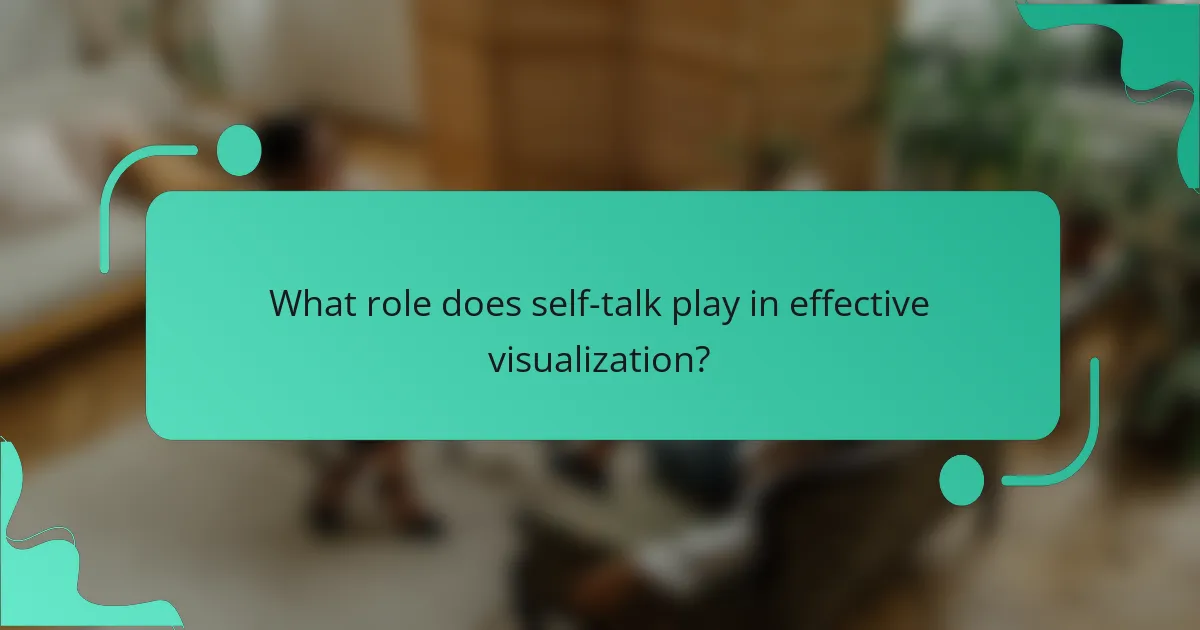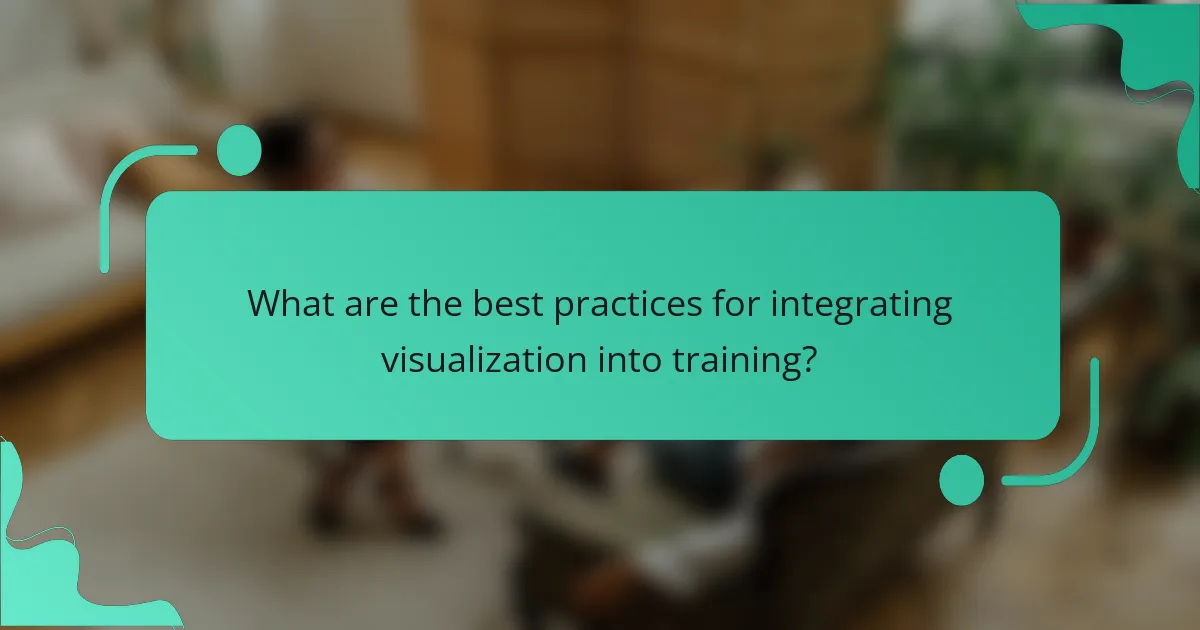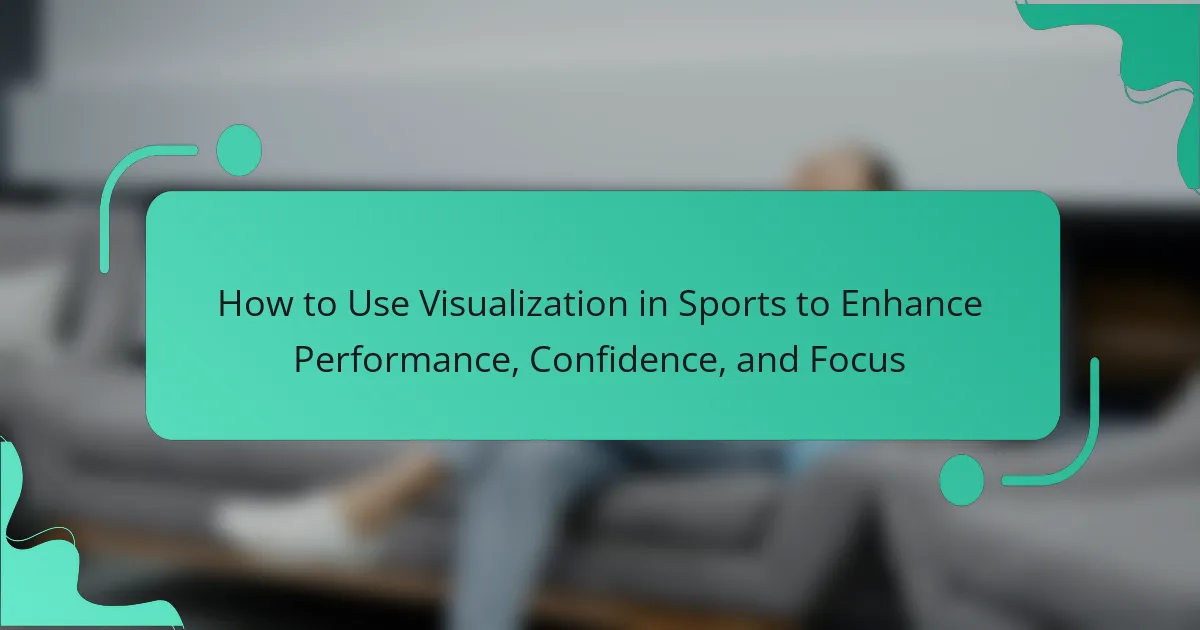Visualization enhances sports performance by improving focus, confidence, and mental clarity. This article explores effective techniques, the role of self-talk, and the impact of neuroplasticity. It also highlights methods for measuring effectiveness and integrating visualization into training routines. Athletes can leverage these strategies to achieve peak performance and maintain composure under pressure.

How does visualization enhance performance in sports?
Visualization significantly enhances sports performance by improving focus, confidence, and mental clarity. Athletes who practice visualization can mentally rehearse techniques, leading to better execution during actual performance. Research shows that mental imagery activates similar brain regions as physical practice, reinforcing skills and boosting confidence. Additionally, visualization aids in stress reduction, allowing athletes to maintain composure under pressure. This technique is essential for peak performance, as it cultivates a positive mindset and sharpens concentration.
What are the psychological mechanisms behind visualization?
Visualization enhances sports performance by engaging psychological mechanisms like mental imagery, self-efficacy, and relaxation response. Mental imagery allows athletes to rehearse skills, boosting confidence and focus. Self-efficacy, the belief in one’s abilities, improves motivation and persistence. The relaxation response reduces anxiety, creating a calm mental state conducive to optimal performance. These mechanisms work together to enhance athletic outcomes.
How does visualization impact the brain during athletic performance?
Visualization significantly enhances athletic performance by improving mental focus and confidence. It activates brain areas associated with motor skills, facilitating better execution of physical tasks. Research shows that athletes who practice visualization exhibit increased performance metrics, such as speed and accuracy. This technique can simulate real-life scenarios, allowing athletes to prepare mentally for competitions. By creating vivid mental images of success, athletes can reduce anxiety and enhance their overall mindset, leading to improved outcomes in their sport.

What role does self-talk play in effective visualization?
Self-talk significantly enhances effective visualization by reinforcing positive beliefs and mental imagery. This internal dialogue shapes an athlete’s mindset, influencing their confidence and focus. Positive self-talk can lead to improved performance by creating a strong emotional connection to the visualized outcomes. Moreover, it serves as a unique attribute, differentiating successful athletes from others by fostering resilience and motivation in challenging situations.
How can positive self-talk amplify visualization techniques?
Positive self-talk enhances visualization techniques by fostering a supportive mental environment. This combination boosts athletes’ confidence, focus, and performance. When athletes visualize success, positive self-talk reinforces their belief in achieving those visualized outcomes. Research shows that athletes who engage in both practices experience improved results, as self-affirmation can increase motivation and reduce anxiety. Integrating positive self-talk into visualization can transform an athlete’s mindset, leading to optimal performance during competitions.
What are common self-talk patterns among successful athletes?
Successful athletes often engage in positive self-talk patterns that enhance their performance. These patterns include affirmations, visualization, and reframing negative thoughts. Affirmations help build confidence by reinforcing belief in their abilities. Visualization involves mentally rehearsing successful performance, which prepares the mind and body for competition. Reframing negative thoughts transforms potential setbacks into opportunities for growth, fostering resilience. These self-talk techniques collectively contribute to improved focus and mental clarity during high-pressure situations.

What unique visualization techniques are used by pro athletes?
Pro athletes use unique visualization techniques like mental imagery, sensory engagement, and goal visualization to enhance performance. Mental imagery involves vividly imagining successful performances, which boosts confidence and focus. Sensory engagement incorporates multiple senses to create a more immersive experience, allowing athletes to feel the environment. Goal visualization helps athletes mentally rehearse their objectives, increasing motivation and clarity. These techniques are tailored to individual preferences, making them effective tools in sports psychology.
How do elite athletes personalize their visualization practices?
Elite athletes personalize their visualization practices by tailoring mental imagery techniques to their specific sports and individual needs. They often focus on detailed scenarios that mirror competitive situations, enhancing performance and confidence.
For instance, a sprinter may visualize the start of a race, including the sound of the gun and the feeling of acceleration. This unique approach allows athletes to create vivid mental rehearsals, improving focus and reducing anxiety.
Additionally, some athletes incorporate sensory elements, such as sounds, emotions, and physical sensations, to create a more immersive experience. This rare attribute of personalization ensures that their visualization aligns closely with their training and competition environments, fostering a stronger mental connection to their performance goals.
What are the steps to create a personalized visualization routine?
To create a personalized visualization routine, follow these steps: define your goals, select specific scenarios to visualize, practice regularly, incorporate sensory details, and evaluate your progress. This structured approach enhances performance, confidence, and focus in sports.
What visualization methods are most effective for different sports?
Visualization methods vary in effectiveness across different sports, tailored to specific performance needs. For team sports like basketball, dynamic visualizations enhance spatial awareness and teamwork. In individual sports such as golf, mental imagery focuses on technique and precision.
Sports like swimming benefit from visualization of stroke mechanics, while endurance sports utilize mental imagery for pacing strategies. Additionally, combat sports employ visualization for anticipating opponents’ moves. Each method aligns with the unique attributes of the sport, enhancing performance, confidence, and focus.

What rare attributes of visualization can provide a competitive edge?
Visualization in sports can leverage rare attributes like neuroplasticity, emotional resonance, and multisensory engagement to provide a competitive edge. Neuroplasticity allows athletes to rewire their brains for improved performance through mental practice. Emotional resonance enhances motivation and focus, creating a deeper connection to goals. Multisensory engagement incorporates various senses, making visualization more vivid and impactful. These unique aspects cultivate a stronger mental framework, ultimately leading to enhanced athletic performance.
How can visualization be used to overcome mental barriers?
Visualization can effectively overcome mental barriers by enhancing focus and boosting confidence. Athletes use mental imagery to envision successful performances, which helps reduce anxiety and improves concentration. This technique allows individuals to mentally rehearse skills, making them more familiar and accessible during actual performance. As a result, visualization not only prepares the mind but also reinforces a positive mindset, enabling athletes to tackle challenges confidently.
What uncommon visualization practices have proven successful?
Visualization practices such as guided imagery, mental rehearsal, and sensory visualization have proven successful in enhancing sports performance. Guided imagery involves creating vivid mental images of successful performances, helping athletes build confidence. Mental rehearsal focuses on practicing skills mentally before executing them physically, improving focus and execution. Sensory visualization incorporates all senses, allowing athletes to experience the environment and emotions associated with their sport, leading to better preparation and performance.

How can athletes measure the effectiveness of their visualization?
Athletes can measure visualization effectiveness by tracking performance metrics, self-assessment, and feedback. They should establish clear goals for visualization sessions, such as improved focus or reduced anxiety. Regularly reviewing these goals against actual performance outcomes provides insight into effectiveness. Additionally, qualitative feedback from coaches or peers can highlight changes in confidence and mental clarity, reinforcing the value of visualization in training.
What metrics can be used to assess performance improvements?
To assess performance improvements in sports visualization, several metrics can be utilized. These include changes in athlete confidence levels, focus during training sessions, and measurable improvements in physical performance metrics such as speed, endurance, or strength. Additionally, subjective assessments through athlete feedback and self-reported experiences can provide insights into the effectiveness of visualization techniques. Tracking these metrics over time can reveal trends and validate the impact of visualization on overall performance.
How does feedback influence visualization practices?
Feedback significantly enhances visualization practices by providing athletes with insights into performance and areas for improvement. Constructive feedback fosters a growth mindset, enabling athletes to refine their mental imagery techniques. This iterative process allows for adjustments in visualization strategies, aligning them more closely with personal goals and performance metrics. As a result, athletes can develop greater confidence and focus, ultimately enhancing their overall performance.

What are the best practices for integrating visualization into training?
Integrating visualization into training enhances performance, confidence, and focus. Key practices include setting clear goals, using vivid imagery, incorporating sensory details, and practicing regularly.
Establish specific performance objectives to guide visualization. For example, athletes might visualize completing a perfect routine or achieving a personal best.
Utilize detailed imagery by imagining the environment, emotions, and physical sensations associated with success. This creates a more immersive experience that enhances neural pathways.
Incorporate sensory details by engaging all five senses during visualization. This approach strengthens the mental rehearsal process and improves retention.
Practice visualization consistently, ideally daily, to reinforce the mental imagery and build confidence over time. Regular practice ensures that the visualization becomes a natural part of the training routine.
How often should athletes practice visualization for optimal results?
Athletes should practice visualization daily for optimal results. Regular sessions enhance performance, confidence, and focus by reinforcing mental imagery. Research indicates that even short, consistent practices yield significant benefits. Aim for at least 10-15 minutes each day to maximize effectiveness.
What common mistakes should athletes avoid when using visualization?
Athletes should avoid several common mistakes when using visualization. Failing to create specific and vivid mental images can limit effectiveness. Neglecting to practice visualization regularly can hinder skill development. Additionally, focusing on negative outcomes instead of positive ones can undermine confidence. Lastly, not aligning visualization with physical training may lead to inconsistency in performance.
How can coaches support athletes in their visualization efforts?
Coaches can significantly enhance athletes’ visualization efforts by providing structured guidance and feedback. They should encourage regular practice of visualization techniques, ensuring athletes create vivid mental images of their performance.
Additionally, coaches can facilitate visualization sessions by incorporating relaxation techniques to improve focus. By offering constructive critiques, coaches help athletes refine their mental imagery, making it more effective.
Establishing a supportive environment fosters confidence, allowing athletes to explore their visualization skills without fear of judgment. Regular discussions about visualization experiences can further deepen athletes’ understanding and application, leading to improved performance outcomes.
What expert insights can enhance visualization techniques?
Expert insights can significantly enhance visualization techniques in sports by focusing on mental imagery, emotional engagement, and performance consistency. Mental imagery, where athletes visualize successful performances, can boost confidence and focus. Emotional engagement during visualization helps athletes connect with their goals, reinforcing motivation. Consistent practice of visualization techniques leads to improved muscle memory and execution during actual performance. Research shows that athletes who regularly use visualization techniques experience enhanced performance outcomes compared to those who do not.
